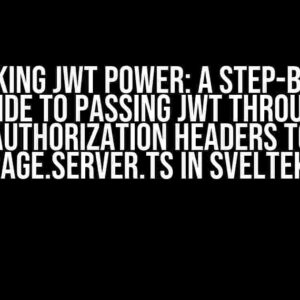Imagine being able to push updates to your users in real-time, without them having to refresh their browser. Welcome to the world of web sockets, where the impossible becomes possible. In this article, we’ll dive into the world of Adonis 6 web sockets, and explore how you can harness their power to take your web applications to the next level.
What are Web Sockets?
Web sockets are a bi-directional communication protocol that allows for real-time communication between a client (usually a web browser) and a server. This means that the server can push updates to the client at any time, without the client having to request it.
The Problem with Traditional HTTP Requests
In traditional HTTP requests, the client sends a request to the server, and the server responds with a response. This is a one-way communication process, where the client has to initiate the conversation. However, what if you want to push updates to the client in real-time, without them having to request it? That’s where web sockets come in.
How Do Web Sockets Work?
A web socket connection is established through a series of handshakes between the client and the server. Here’s a high-level overview of how it works:
- The client sends a request to the server to establish a web socket connection.
- The server responds with a 101 Switching Protocols response, indicating that it will switch to the web socket protocol.
- A WebSocket upgrade header is sent by the server to the client, which includes the WebSocket protocol version and other necessary information.
- The client and server establish a bi-directional communication channel, allowing for real-time communication.
Adonis 6 Web Sockets
Adonis 6 is a Node.js framework that provides a robust and scalable way to build web applications. One of its key features is built-in support for web sockets, making it easy to add real-time communication to your applications.
Setting Up Adonis 6 Web Sockets
To get started with Adonis 6 web sockets, you’ll need to install the `@adonisjs/websocket` package. You can do this by running the following command in your terminal:
npm install @adonisjs/websocketNext, you’ll need to register the web socket provider in your Adonis 6 application. You can do this by adding the following code to your `start/app.js` file:
const { WsServer } = require('@adonisjs/websocket')
WsServer.boot()
Creating a Web Socket Server
To create a web socket server, you’ll need to define a web socket handler. A web socket handler is a function that will be called when a new web socket connection is established. Here’s an example of how you can define a web socket handler:
const { Ws } = require('@adonisjs/websocket')
Ws.handler('my-namespace', (ws) => {
console.log('New connection established')
ws.on('message', (message) => {
console.log(`Received message: ${message}`)
})
ws.on('close', () => {
console.log('Connection closed')
})
})
In this example, we’re defining a web socket handler for the `my-namespace` namespace. When a new connection is established, the handler function will be called, and we’ll log a message to the console. We’re also listening for `message` and `close` events, which will be triggered when the client sends a message or closes the connection, respectively.
Connecting to the Web Socket Server
Now that we have our web socket server set up, let’s connect to it from the client-side. You can do this using the `ws` library in your client-side JavaScript code. Here’s an example:
const socket = new WebSocket('ws://localhost:3333/my-namespace')
socket.onmessage = (event) => {
console.log(`Received message: ${event.data}`)
}
socket.onclose = () => {
console.log('Connection closed')
}
socket.send('Hello, server!')
In this example, we’re creating a new web socket connection to our server, and listening for `message` and `close` events. We’re also sending a message to the server, which will trigger the `message` event on the server-side.
Use Cases for Adonis 6 Web Sockets
Web sockets are a powerful technology that can be used in a wide range of applications. Here are some examples of use cases for Adonis 6 web sockets:
- Real-time Chat Applications: Web sockets are perfect for building real-time chat applications, where messages need to be pushed to users in real-time.
- Live Updates: Web sockets can be used to push live updates to users, such as scores, stock prices, or weather updates.
- Gaming: Web sockets are ideal for building real-time gaming applications, where fast and efficient communication is crucial.
- IOT Applications: Web sockets can be used to communicate with IoT devices in real-time, enabling features such as remote monitoring and control.
Best Practices for Adonis 6 Web Sockets
When working with Adonis 6 web sockets, there are some best practices to keep in mind:
- Use Namespaces: Use namespaces to separate different types of web socket connections, and to avoid conflicts between different applications.
- Use Event-driven Architecture: Use event-driven architecture to handle web socket events, making it easy to scale and maintain your application.
- Use Authentication and Authorization: Use authentication and authorization to secure your web socket connections, and to ensure that only authorized users can connect.
- Monitor and Debug: Monitor and debug your web socket connections to ensure that they are working as expected, and to identify any issues that may arise.
Conclusion
In this article, we’ve explored the world of Adonis 6 web sockets, and learned how to harness their power to build real-time web applications. We’ve covered the basics of web sockets, how to set up an Adonis 6 web socket server, and how to connect to it from the client-side. We’ve also looked at some use cases for Adonis 6 web sockets, and some best practices to keep in mind.
If you’re building a web application that requires real-time communication, Adonis 6 web sockets are definitely worth considering. With their bi-directional communication protocol, you can push updates to your users in real-time, without them having to refresh their browser.
| Web Socket Feature | Description |
|---|---|
| Bi-directional Communication | Allows for real-time communication between the client and server. |
| Real-time Updates | Enables real-time updates to be pushed to users, without them having to request it. |
| Scalability | Allows for horizontal scaling, making it easy to handle large numbers of users. |
| Security | Provides built-in security features, such as authentication and authorization. |
By following the instructions in this article, you can unlock the power of real-time communication and take your web applications to the next level. Happy coding!
Frequently Asked Question
Get the lowdown on Adonis 6 web sockets and unlock the power of real-time communication!
What are Adonis 6 web sockets and how do they work?
Adonis 6 web sockets are a bi-directional communication channel between the client and server, allowing for real-time communication. They work by establishing a persistent connection between the client and server, enabling the server to push updates to the client at any time. This allows for efficient and scalable communication, making it perfect for applications that require live updates, such as live scoring, stock prices, or chat apps!
What are the benefits of using Adonis 6 web sockets?
The benefits of using Adonis 6 web sockets are numerous! They enable real-time communication, reduce latency, and improve user experience. They also allow for efficient use of resources, as the server only needs to send updates when necessary. Additionally, Adonis 6 web sockets provide a scalable solution, making them perfect for high-traffic applications.
How do I set up Adonis 6 web sockets in my application?
Setting up Adonis 6 web sockets is a breeze! First, you’ll need to install the `adonis-websocket` package. Then, create a new WebSocket instance and define your routes. Finally, connect to the WebSocket from your client-side application and start receiving updates in real-time!
Can I use Adonis 6 web sockets with multiple clients?
Absolutely! Adonis 6 web sockets support multiple clients out of the box. You can broadcast messages to all connected clients or target specific clients using rooms. This makes it perfect for applications that require real-time communication between multiple users.
Are Adonis 6 web sockets secure?
Yes, Adonis 6 web sockets prioritize security! They use the WebSocket protocol, which provides a secure and encrypted connection between the client and server. Additionally, Adonis 6 provides features like authentication and authorization to ensure that only authorized clients can connect to your WebSocket.






